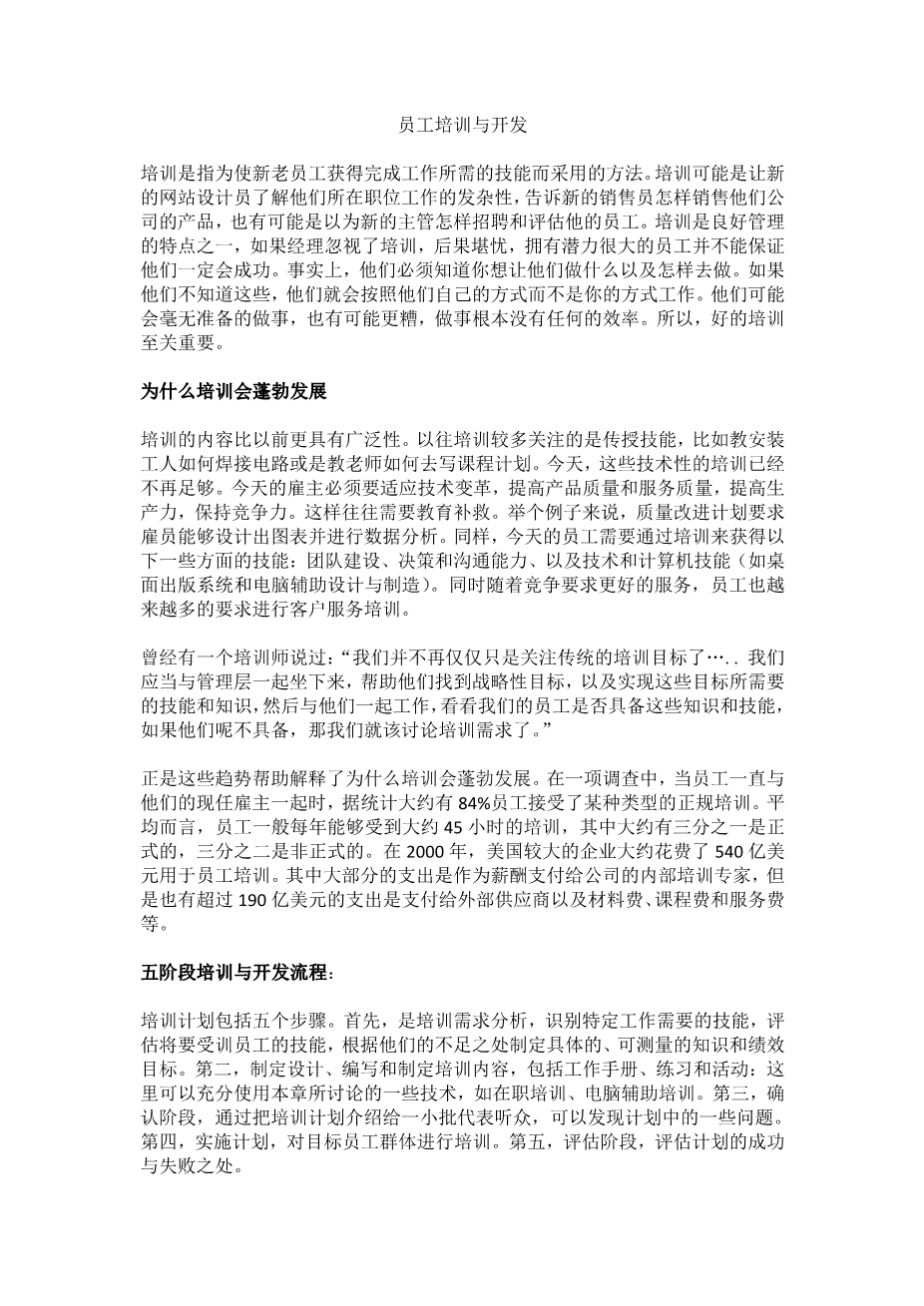1.Christianne Derouen,Brian H. Kleiner.New Developments in Employee Training[J].Work Study
New Developments in Employee Training
In order to accommodate the rapid technological changes, employees must mas-ter increasingly complex technical skills. Five major forces behind training becoming so important and central to any firmrsquo;s operations are as follows:
(1) global and domestic competition;
(2) changes in technology;
(3) mergers, acquisitions and divestitures causing realignment of structures and functions of companies;
(4) better educated workforce;
(5) emergence of new occupations(computer,etc.).
New training ideas are developed because trends are towards making training more practical, realistic and pertaining to employeesrsquo; jobs.
Training must give em-ployees broader knowledge, enabling them effectively to utilize new technology and integrate it into the workplace.
Lower costs, better quality, faster return on investment,increased productivity and long-term growth are all achieved once employees adapt to changes and are trained accordingly. In the past, training was very class-room/instructororiented.This has recently proven ineffective compared with more modern developments.
Two books published in 1988[1,2] discuss many companies and modern em-ployee-training ideas which are being utilized today to keep pace with technology. The four areas addressed are:
(1) aligning training strategies with corporate goals;
(2) continuous learning;
(3) manufacturer-user; and
(4) designing and delivering training cost-effectively.
Additionally, various magazine articles supplement some of the ideas discussed in the two books as well as introduce new training methods.
Aligning Training Strategies with Corporate Goals
The first type of training mentioned in the above books discusses aligning train-ing strategies with corporate goals, which is necessary because each company must evaluate what is needed for it to be competitive and successful. Once this is known, training can be applied accordingly.
American Transtech,a subsidiary of ATamp;T,aligns its training with corporate goals by focusing its training in the following manner: managers are trained to hire their own personnel, relying less on Human Resources. Once hired, new employees go through a two-day orientation where company policy and procedures are outlined and teamwork participation is encouraged, since teamwork is an integral part of American Transtech. On completion of the orientation, the new hires are placed in groups and trained about their job and its functions with the aid of a computer. There are no instructors leading the class, so it is necessary for the teams to discuss among themselves various problems and assignments presented to them on the computer.
Group training follows the employees to the workplace, where groups often meet to discuss needs and problems of the company. From this process the goals of training for the company are met. The computer/no instructor process is not mentioned very often but is a more modern way to train as computer use is so widespread. American Transtech found this method is successful in getting people to work together as well as learn together.
Corning Glass Works is another company which implemented a training pro-gramme aligned with its corporate goals. Training is so important to Corning Glass that it felt the training given would directly relate to success and hopefully put it a step ahead of its competition. The corporation, with the help of outside consultants, put together a textbook about quality at Corning Glass. The training department worked hard exposing all 28,000 employees to training in product and people quality. Mid-level management was the focus of the training. The book was used as a guide-line, and the emphasis was teamwork. From the initial training, Corning Glass found problem areas which needed to be addressed in further company training courses, in-cluding interpersonal relationships and problem solving.
Though use of books is by no means a modern training method, a company writing its own book for training purposes and updating as needs arise is not a commonality. Most companies rely on outside training courses.
Continuous Learning
More recent trends show training going beyond “job specific” to “continuous learning”, in which the focus is on other areas of expertise within the company. In continuous learning employees are encouraged to learn and understand the jobs and skills needed of those around them and more often perform them on a regular basis. Semiautonomous work teams are most conducive in the continuous learning envi-ronment because each employee trains others in their group. This way employees know one anotherrsquo;s jobs and can perform them in case of an employee absence. Em-ployees begin to realize that learning and continuous training is as big a part of their job as the job itself.
Training one another, or “train the trainer”, is another important aspect of conti-nuous learning. It allows employees to develop new applications and techniques and share them with their peers or supervisors.
S.B. Thomas, Inc. feels there are two types of training in its continuous learning plan – social and technical task training. In social training employees are given a sec-ondary job, such as communicator, counsellor, safety officer. These secondary jobs change frequently and are minor jobs compared with the job for which they are hired, but it gives employees a “teamwork” sense of pride in productivity. Although this is not an actual training course in the truest sense, it is a training method to increase em-ployeesrsquo; morale, and good employee morale increases work output as well as inter-personal relations.
The technical task training is focused on learning the job which the employee will
剩余内容已隐藏,支付完成后下载完整资料
英语译文共 4 页,剩余内容已隐藏,支付完成后下载完整资料
资料编号:[612711],资料为PDF文档或Word文档,PDF文档可免费转换为Word
课题毕业论文、外文翻译、任务书、文献综述、开题报告、程序设计、图纸设计等资料可联系客服协助查找。




